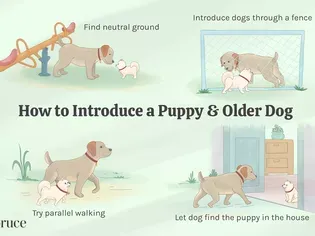How to Train an Older Dog to Accept a New Puppy
Updated on 04/26/24

How to Train an Older Dog to Accept a New Puppy: A Comprehensive Guide
Welcoming a new puppy into your home can be an exciting yet challenging time, especially if you already have an older dog. Introducing a new furry family member can disrupt the established hierarchy and create potential conflicts. Fortunately, with patience, understanding, and the right training techniques, you can help your older dog accept and even bond with the new puppy.
Understanding Your Older Dog's Perspective
Before embarking on the training process, it's crucial to understand your older dog's perspective. Changes to their routine, territory, and affection levels can be unsettling. They may feel threatened by the new puppy or resent its playful antics. Recognizing these potential concerns will guide your training approach.
Gradual Introduction
Avoid introducing the dogs abruptly. Instead, follow a gradual process to minimize potential confrontations.
* Leash and Control: Initially, keep both dogs on leashes during interactions, allowing them to sniff each other from a distance. Gradually reduce the distance as they become more comfortable.
* Supervised Playtime: Arrange supervised playtime sessions where the puppy is leashed and the older dog has ample space to retreat. Reward both dogs for positive interactions.
* Separate Feeding: Feed the dogs separately in different locations to avoid food-related aggression.
Positive Reinforcement and Patience
Reward-based training is essential for both dogs. When the older dog exhibits calm and accepting behavior towards the puppy, reward them immediately with treats, praise, or attention. Avoid punishing the older dog for any aggression or negative behavior, as this will only exacerbate the situation.
* Redirect Unwanted Behaviors: If the older dog growls or snaps at the puppy, gently redirect their attention by offering a treat or toy.
* Create a Safe Haven: Provide a safe place for the older dog to retreat to, such as a crate or their own private room.
* Avoid Overwhelming the Older Dog: Limit the duration and intensity of interactions between the dogs until the older dog is fully comfortable.
Preventing Resource Guarding
Resource guarding, where a dog becomes aggressive towards others when they approach a valued item, is a common issue that can arise when introducing a new puppy. To prevent this, avoid giving the puppy access to the older dog's food, toys, or favorite sleeping spots.
* Controlled Access: Supervise all interactions and gradually introduce shared resources, such as a treat-dispensing toy.
* Positive Association: Pair the puppy's presence with positive experiences, such as giving your older dog treats or petting them while the puppy is nearby.
* Trade-Ups: If resource guarding occurs, calmly exchange the guarded item for a higher-value treat or toy.
Bonding Activities
Once the older dog has accepted the puppy, fostering a bond between them is crucial for their long-term happiness.
* Joint Activities: Take both dogs on walks together, play fetch, or engage in other activities that encourage cooperation and shared experiences.
* Positive Socialization: Introduce the dogs to new environments and experiences together, such as visiting the park or attending obedience classes.
* Shared Grooming: Groom both dogs simultaneously to create a sense of togetherness and reduce competition for your attention.
Addressing Specific Challenges
* Age Difference: If the older dog is much older than the puppy, they may have less energy or patience for rambunctious play. Adjust interactions accordingly and provide ample rest time for the older dog.
* Size Difference: Large puppies can intimidate smaller older dogs. Supervise interactions closely and prevent the puppy from overwhelming the older dog with their energy.
* Previous Negative Experiences: If the older dog has a history of negative interactions with other dogs, seek professional guidance to address underlying issues before introducing a new puppy.
Conclusion
Training an older dog to accept a new puppy requires patience, understanding, and consistent application of positive reinforcement techniques. By following the steps outlined above, you can help your older dog adjust to the new addition to your family while fostering a harmonious and loving bond between them. Remember that every dog is unique, so tailor the training approach to their individual needs and personality. With time and effort, your older dog and the new puppy can become the best of friends.
Explore More Pets

Basic Training
Puppy and Baby Introductions

Working Dog Breeds
All About Search and Rescue Dogs

Dog Treatments
Puppy Vaginitis: Signs, Causes and Treatment

Dog Adoption
After More Than 1,200 Days in the Shelter, Coco Goes Home

Basic Training
How to Train Your Puppy to Go on Potty Pads

Hybrid Dog Breeds
The Difference Between a Mutt, Mixed Breed, or Designer Dog?

Dog Treatments
Nail Problems in Dogs

Puppies
7 Reasons Why Two Dogs Are Better Than One